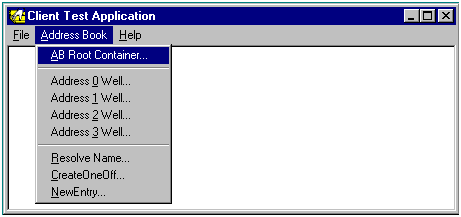
To use the Address Book Viewer, start ABVIEW.EXE or ABVIEW32.EXE, depending on your platform. The Address Book Viewer uses a series of dialog boxes driven by menu selections to display and prompt for information. If you are not already running a messaging client application such as Microsoft Exchange, the Address Book Viewer will first prompt you for the name of a profile. If you are running a messaging client, the Address Book Viewer will use the profile that the client is currently using.
If you are running the Address Book Viewer for the first time, select Configure from the Help menu and enter the DLL names of the Table Viewer and Property Viewer. Depending on your target platform, enter TBLVU32.DLL or TBLVU.DLL in the field labeled "Table Vu DLL" and PROPVU32.DLL or PROPVU.DLL in the field labeled "Property Vu DLL." All of the other fields may be left blank.
After this initial configuration, you can use any of the three Address Book Viewer menus. There is a File menu to start and end MAPI session and a Help menu to display information about the Address Book Viewer and to perform configuration. The primary menu is the Address Book menu. With the selections from the Address Book menu, you can display the properties of containers, messaging users, and distribution lists and invoke several methods of the IAddrBook interface.
The menus of the Address Book Viewer appear as follows:

When you use the File menu to log on to MAPI, the Address Book Viewer calls MAPILogonEx to establish a MAPI session. If you're debugging an address book provider, its ABProviderInit function and IABProvider::Logon method are called at this point. The Address Book Viewer also calls IMAPISession::OpenAddressBook to make the address book accessible. When you log off, the Address Book Viewer releases its pointer to the address book, calls IMAPISession::Logoff, and then releases its session pointer.
The Address Book menu provides selections for displaying information about the root container, for displaying messaging user or distribution list properties, for building a recipient list using one, two, or three wells, and for invoking the following IAddrBook methods:
For more information about the Address Book menu selections, see one of the following topics:
Displaying the Properties of Container Entries
The Help menu provides two selections: About and Config. The About selection provides summary information about the Address Book Viewer including its full name and version. The Config selection displays a dialog box that you can use to configure the Address Book Viewer. For more information about how to configure the Address Book Viewer, see Configuring the Address Book Viewer.